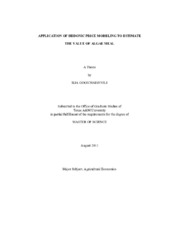| dc.description.abstract | High productivity rates, usage of nonproductive land, renewability and recovery of waste nutrients and potential for CO2 emission reduction represent some of the advantages that selected algae species might have over competing products. Many research studies have investigated potential usage of algae for different purposes, such as cosmetics or aquaculture; however most of the research studies have focused on the feasibility of algae as a source of second generation biodiesel and feed meal. Because of its high costs of production, using algae only for the purpose of biodiesel production might not be profitable. Thus, for global scale algae commercialization it is important that it be used as a feed meal along with being marketed to the biodiesel industry.
One of the major problems faced by economists when attempting to analyze the feasibility of algae is the absence of a market for algae-based fuel and meal. Given that no market exists, prices for algae cannot be observed and realistic investment analysis becomes difficult to perform in this sector.
The objective of this study is to estimate a potential price of algae meal using hedonic pricing techniques. For that purpose, twenty two different feed meals commonly having the same usage as Post Extracted Algae Residue (PEAR) are decomposed into their chemical constituents in order to calculate the market value of each characteristic. Calculated prices of these characteristics are then used to estimate the price of algae meal and compare it to different feed meals.
Results suggest that algae prices are strictly variable to its chemical components across different algae types. Besides, PEAR represents a sustainable source of financial
value and might be considered one of the cornerstones in making algae commercialization a feasible and profitable option. | en |


